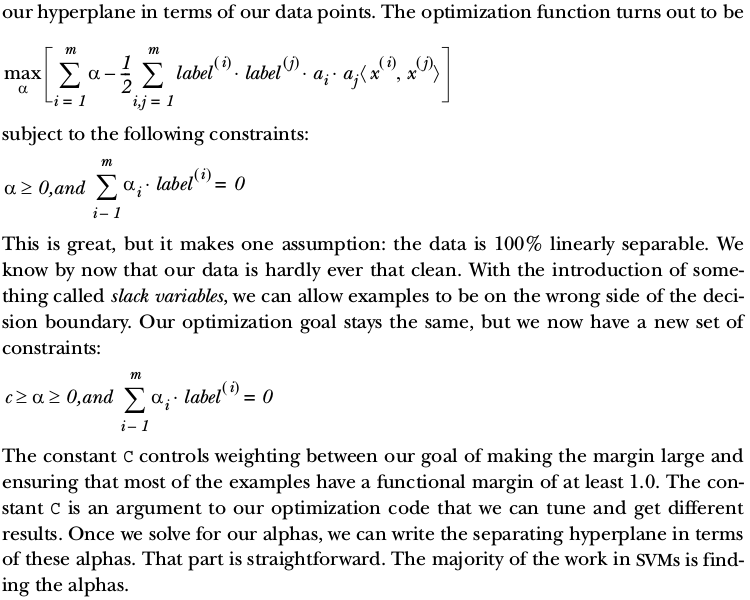Separate data with the maximum margin
Some Concepts
- Linearly Separable: Can use a (N-1) dimensions to separate the N dimensions dataset. Such as draw a straight line on the figure to separate the 2D points
- Separating Hyperplane: the decision boundary used to separate the dataset.
- Support Vector: The points closest to the separating hyperplane are known as support vectors.
Find the maximum margin
Can see some reference here
Efficient optimization with SMO algorithm
from numpy import *
def loadDataSet(fileName):
dataMat = []; labelMat = []
fr = open(fileName)
for line in fr.readlines():
lineArr = line.strip().split('\t')
dataMat.append([float(lineArr[0]), float(lineArr[1])])
labelMat.append(float(lineArr[2]))
return dataMat, labelMat
def selectJrand(i, m):
j = i
while (j == i) :
j = int(random.uniform(0, m))
return j
def clipAlpha(aj, H, L):
if aj > H:
aj = H
if L > aj:
aj = L
return aj
def smoSimple(dataMatIn, classLabels, C, toler, maxIter):
dataMatrix = mat(dataMatIn); labelMat = mat(classLabels).transpose()
b = 0; m, n = shape(dataMatrix)
alphas = mat(zeros((m,1)))
# iter, which is used to hold a count of the number of times you've gone through the dataset
# without any alphas changing. When iter reaches the value of the input maxIter, just exit!
iter = 0
while (iter < maxIter) :
# alphaPairsChanged is used to record if the attempt to optimize any alphas worked.
alphaPairsChanged = 0
for i in range(m):
# fXi: prediction of the class.
fXi = float(multiply(alphas, labelMat).T * \
(dataMatrix * dataMatrix[i, :].T)) + b
# alphas:[m*1], labelMat:[m*1] , dataMatrix:[m*n], dataMatrix[i, :].T: [n*1] b is a number
Ei = fXi - float(labelMat[i])
# if can not satisfy the if statement, they're "bound" enough, which means
# that the abs(Ei) isn't large enough, they're quite right.so it isn't worth
# trying to optimize these alphas
if ((labelMat[i] * Ei < -toler) and (alphas[i] < C) or \
((alphas[i] > 0) and (labelMat[i] * Ei > toler))):
j = selectJrand(i, m)
fXj = float(multiply(alphas, labelMat).T * \
(dataMatrix * dataMatrix[j, :].T)) + b
Ej = fXj - float(labelMat[j])
# use copy() so we can compare the new and the old ones
alphaIold = alphas[i].copy()
alphaJold = alphas[j].copy()
# L, H is used for clamping alpha[j] between 0 and C.
if (labelMat[i] != labelMat[j]):
L = max(0, alphas[j] - alphas[i])
H = min(C, C + alphas[j] - alphas[i])
else:
L = max(0, alphas[j] + alphas[i] - C)
H = min(C, alphas[j] + alphas[i])
if L == H:
print "L == H"; continue
# Eta is the optimal amount to change alphas[j]
eta = 2.0 * dataMatrix[i, :] * dataMatrix[j, :].T - \
dataMatrix[i, :] * dataMatrix[i, :].T - \
dataMatrix[j, :] * dataMatrix[j, :].T
if eta >= 0:
print "eta >= 0"; continue
alphas[j] -= labelMat[j] * (Ei - Ej) /eta
alphas[j] = clipAlpha(alphas[j], H, L)
if (abs(alphas[j] - alphaJold) < 0.00001):
print "j not moving enough"; continue
alphas[i] += labelMat[j] * labelMat[i] * (alphaJold - alphas[j])
b1 = b - Ei - labelMat[i] * (alphas[i] - alphaIold) * \
dataMatrix[i, :] * dataMatrix[i, :].T - \
labelMat[j] * (alphas[j] - alphaIold) * \
dataMatrix[i, :] * dataMatrix[j, :].T
b2 = b - Ej - labelMat[i] * (alphas[i] - alphaIold) * \
dataMatrix[i, :] * dataMatrix[j, :].T - \
labelMat[j] * (alphas[j] - alphaJold) * \
dataMatrix[j, :] * dataMatrix[j, :].T
if (0 < alphas[i]) and (C > alphas[i]):
b = b1
elif (0 < alphas[i]) and (C > alphas[i]):
b = b2
else:
b = (b1 + b2)/2.0
alphaPairsChanged += 1
print "iter: %d i: %d, pairs chaged %d" %(iter, i, alphaPairsChanged)
if (alphaPairsChanged == 0):
iter += 1
else: iter = 0
print "iteration number: %d" % iter
return b, alphasSpeeding up with full Plat SMO
The only difference lies in the How we select which alpha to use in the optimization.
The full Platt uses some heuristic to increase the speed.
- The Platt SMO algorithm has an outer loop for choosing the first alpha.
- The second alpha is chosen using an inner loop after we’ve selected the first alpha in a way that will maximize the step size during optimization.
- In simplified SMO, we calculate the error Ej after choosing j.
j = selectJrand(i, m)
fXj = float(multiply(alphas, labelMat).T * \
(dataMatrix * dataMatrix[j, :].T)) + b
Ej = fXj - float(labelMat[j])- In full Platt SMO, we’re going to create a global cache of error value and choose from the alphas that maximize step size, or Ei−Ej






















 418
418











 被折叠的 条评论
为什么被折叠?
被折叠的 条评论
为什么被折叠?








